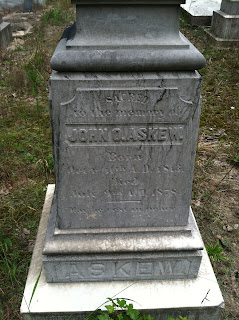My father and I had the recent opportunity to visit
North Carolina in search of our ancestors aka ‘Chasing Ghosts’. I had previously mentioned in my Blog Post Early
Mississippi Settlers that my GGGGrandfather, David Outlaw Askew, was
originally from North Carolina and had moved to Mississippi in 1846. I also have a Blog Post on my ancestors that
were Virginia Colonists entitled Virginia
Colonists – Isle of Wight. In
between the Virginia colony and Mississippi Ancestors, roughly three generations
of my ancestors lived in North Carolina from about 1730 to 1846, just a little
over a century, primarily in Bertie County.
My direct North Carolina ancestors were David Outlaw Askew, John Askew
(1778-1829, father of David Outlaw Askew), and David Askew (1740 – 1815,
grandfather of David Outlaw Askew). David Askew was actually born in Isle of
Wight, Virginia and moved to Bertie County, North Carolina.
David
Askew was a Planter who owned 1400 Acres in Bertie County, NC. In 1768 he purchased 150 Acres from William
Outlaw and on February 5, 1794 received another 162 acres in Quiopksan Swamp;
also from William Outlaw. On January 10,
1794, he received 320 acres in Bertie County, North Carolina on the south side
of stony creek, adjoining property of Capt. William Outlaw. He married Millicent (aka Milly) Outlaw
daughter of Edward Outlaw. Milly and
David had a large family of eight children.
He received land in North Carolina from George Outlaw Sr. in 1768 and
1804. David died in 1815.
His
son, John Askew (father of David Outlaw Askew), was also a substantial
landowner and prominent citizen in Bertie county. The John Askew will of 1827
and will of his wife, Mary Outlaw Askew in 1835 identify eight children as
heirs. He was possibly a member of Capt Henry W. Will's Company in March 1813,
during the War of 1812.
David
Outlaw Askew, my GGGGrandfather, was born on 31 January 1794 in Duplin, NC
(Bertie County). David Outlaw was a
State Senator in the North Carolina State Senate during 1827-28 for Hertford
County, NC. He married Martha Etheridge,
daughter of William Etheridge and the family moved to Mississippi in
approximately 1846.
We have done some extensive search of records; but,
I had not had the opportunity to travel to their former location in North
Carolina … I finally had the opportunity and took it.
Our
first stop was Edenton, NC which is on the banks of the Albemarle Bay. The first permanent settlement in North
Carolina, Edenton is the ''mothertown'' of the State. Edenton at once became the focal point of
civilization in the Province, the capital of the Colony and the home of the
Royal Governors. Originally incorporated
in 1715 as ''The Towne on Queen Anne's Creek,'' and later as ''Ye Towne on
Mattercommack Creek'' and, still later as ''The Port of Roanoke,'' the spot was
named Edenton in 1722 in honor of Governor Charles Eden. It served as the capital of North Carolina from 1722 to 1743. It is quite likely that my ancestors visited
the town.
 |
| Town of Edenton, NC |
 |
| Marina at Edenton, NC |
The
county that my ancestors are from is primarily Bertie County. The county was
formed as Bertie Precinct in
1722 and named for James and Henry Bertie; both Lords Proprietors of the
Carolina Colony. Bertie County is
one of the largest counties in North Carolina, spanning 741 square miles. By 1780, Bertie County had been divided to
resemble its current shape. It is in the
northeastern section of the State and is bounded by Albemarle Sound, Chowan
River, and Washington, Martin, Halifax, Northampton and Hertford Counties. After only seven years as a Proprietary
Province (1722-1729), Bertie County became a province of the Crown. The Crown
sought to strengthen the colony's dependence on England and placed governors,
judges and other officials on salary answering only to the Crown and not the
electorate. North Carolina settlers had become used to the "off-hand"
manner of the Proprietors and resented this "control". Bertie
County's county seat is Windsor, which was established in 1766 and was made
county seat in 1774. The County includes the eight incorporated
townships of Askewville, Aulander, Colerain, Kelford, Lewiston-Woodville,
Powellsville, Roxobel and Windsor.
Bertie County is comprised of fertile uplands and lowlands, with some large
swamps called pocosins, making Bertie County ideal for agriculture. In
addition, the timber industry is key to the area. Livestock and the growing
poultry industry, which focuses on broiler production, are major contributors
to Bertie County's agriculture base.
 |
| Township Map of Bertie County |
Our next stop was Askewville, North Carolina. Obviously, my ancestors are from this
area. It is certainly not a very large
town, as of the census of 2000, there were 180
people, 75 households, and 60 families residing in the town. We were not
able to find much on the history of Askewville; but, this will certainly make a
great research project for a future Blog Post.
 |
| At Askewville |
My goal was to locate the grave site of my GGGGGrandfather,
John Askew, father of David Outlaw Askew.
Unfortunately, we did not find it; however, with a little help from my
brother, we did find the grave of John O. Askew (1813 – 1878), the nephew of my
GGGGGrandfather John Askew and First Cousin to David Outlaw Askew. He was in an Askew Family Cemetery that is
well maintained and near the site of Pitts Landing, North Carolina, not very
far from Askewville.
 |
| Askew Family Cemetery |
 |
| Grave Site of John O. Askew |
I will plan on another trip in the future after a
little more research … at least now I have a better idea of the lay of the land
and the best route to Askewville.







